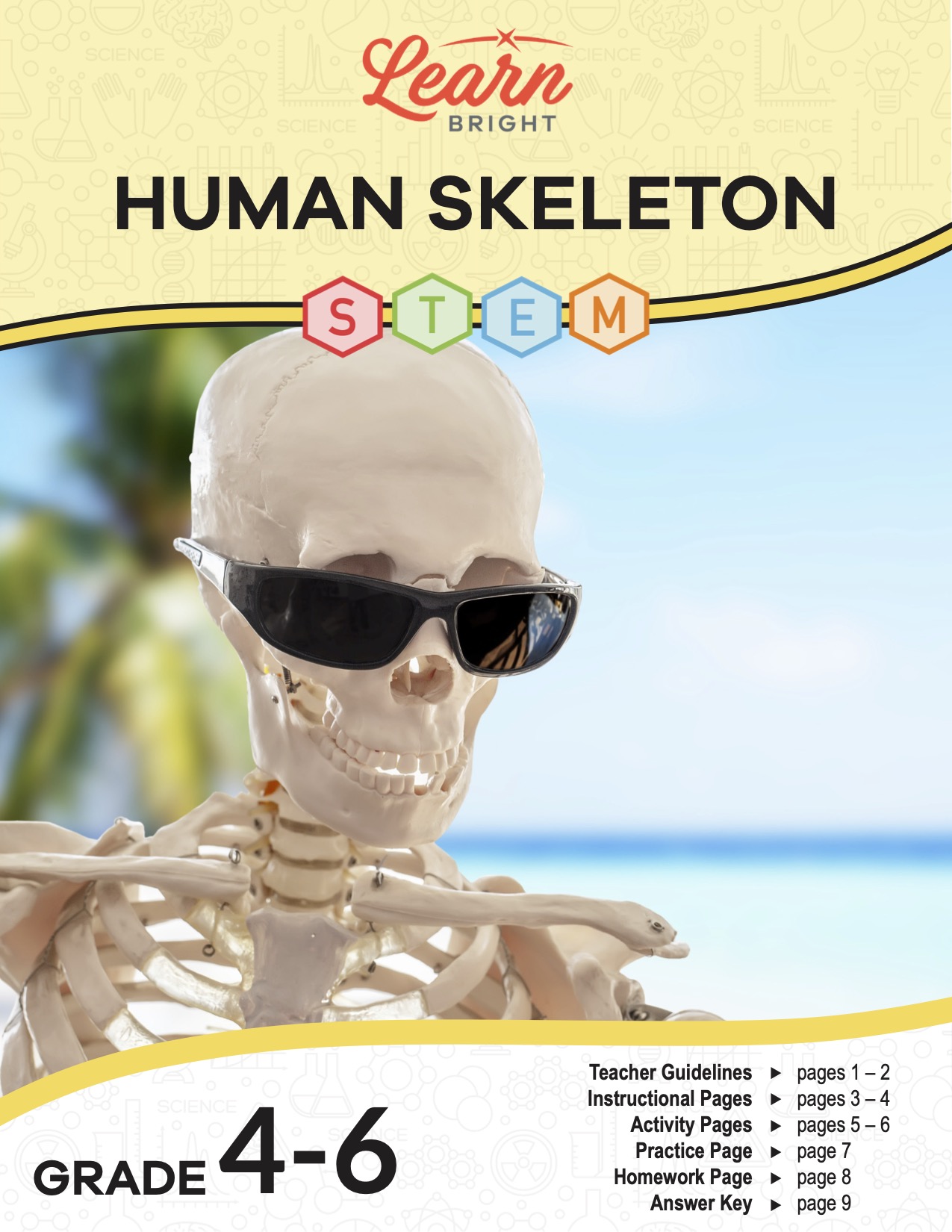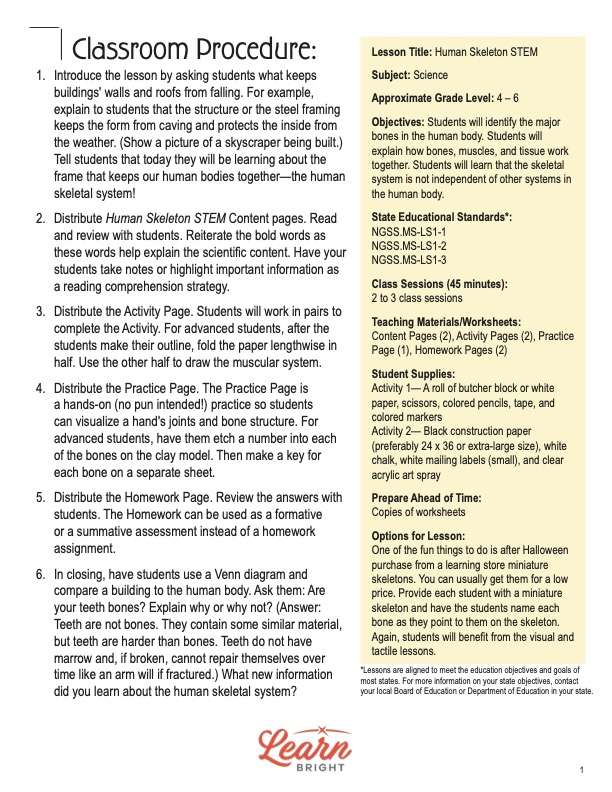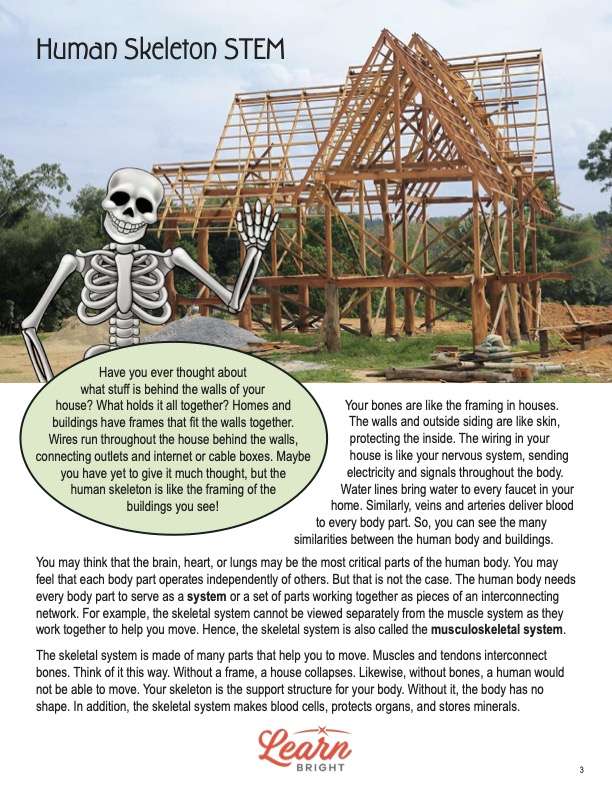Description
What our Human Skeleton STEM lesson plan includes
Lesson Objectives and Overview: Human Skeleton STEM teaches students about the major bones in the human body. Students will discover that bones, muscles, and tissue work together to help the body move and function properly. They will learn that the skeletal system is not independent of other body systems. This lesson is for students in 4th grade, 5th grade, and 6th grade.
Classroom Procedure
Every lesson plan provides you with a classroom procedure page that outlines a step-by-step guide to follow. You do not have to follow the guide exactly. The guide helps you organize the lesson and details when to hand out worksheets. It also lists information in the yellow box that you might find useful. You will find the lesson objectives, state standards, and number of class sessions the lesson should take to complete in this area. In addition, it describes the supplies you will need as well as what and how you need to prepare beforehand. The only supplies you will need apart from the handouts are scissors and glue or tape. In addition, before you deliver the lesson, you should develop a list of movements for step 1 in the classroom procedure.
Options for Lesson
There are several ideas in the “Options for Lesson” section of the classroom procedure page that you might find useful or interesting and want to add to the lesson. One of the fun things to do is after Halloween purchase from a learning store miniature skeletons. You can usually get them for a low price. Provide each student with a miniature skeleton and have the students name each bone as they point to them on the skeleton. Again, students will benefit from the visual and tactile lessons.
Teacher Notes
The teacher notes page provides an extra paragraph of information to help guide the lesson and remind you what to focus on. The paragraph explains some of the key content that you will teach students and mentions that the main objective is for them to be able to identify major bones in the human body. You can use the blank lines to write down any ideas or thoughts you have about the topic as you prepare.
HUMAN SKELETON STEM LESSON PLAN CONTENT PAGES
Bones as the Structure
The Human Skeleton STEM lesson plan contains four content pages. Have you ever thought about what stuff is behind the walls of your house? What holds it all together? Homes and buildings have frames that fit the walls together. Wires run throughout the house behind the walls, connecting outlets and internet or cable boxes. Maybe you have yet to give it much thought, but the human skeleton is like the framing of the buildings you see!
Your bones are like the framing in houses. The walls and outside siding are like skin, protecting the inside. The wiring in your house is like your nervous system, sending electricity and signals throughout the body. Water lines bring water to every faucet in your home. Similarly, veins and arteries deliver blood to every body part. So, you can see the many similarities between the human body and buildings.
You may think that the brain, heart, or lungs may be the most critical parts of the human body. You may feel that each body part operates independently of others. But that is not the case. The human body needs every body part to serve as a system or a set of parts working together as pieces of an interconnecting network. For example, the skeletal system cannot be viewed separately from the muscle system as they work together to help you move. Hence, the skeletal system is also called the musculoskeletal system.
The skeletal system is made of many parts that help you to move. Muscles and tendons interconnect bones. Think of it this way. Without a frame, a house collapses. Likewise, without bones, a human would not be able to move. Your skeleton is the support structure for your body. Without it, the body has no shape. In addition, the skeletal system makes blood cells, protects organs, and stores minerals.
Bone Parts and Functions
Students will discover that if you take a bone and slice it in half, you will see that bones are made of different parts. The periosteum is a membrane that covers the outside of the bone. The compact bone is white, hard, and smooth. It provides structural support and protection. The core (the inner layer of the bone) is softer than compact bone and is called spongy bone. The spongy bone has tiny pores that store marrow. Marrow makes red and white blood cells. Red cells carry oxygen, and white cells fight infections.
Bones perform several vital functions in conjunction with other body systems. In addition to giving shape to the human body, our skeleton supports our body weight. Without strong bones, a human cannot stand or walk upright. Blood cells are produced in the bone marrow. And bones protect critical organs. For example, the skull protects your brain, the ribs protect your heart and lungs, and the backbone protects your spine. Minerals like calcium and vitamin D are critical to human life and stored in bones.
Interesting Facts about the Human Skeleton
The lesson then provides a list of some cool facts about our bones. Babies are born with 300 bones, but when we become adults, we only have 206. Some bones fuse or join to form a single bone as we age. The femur (thigh) is the longest bone. And the smallest is in your ear—the stapes or stirrup bone. The stapes is only 0.11 inches big! Your funny bone is not actually a bone. It’s a nerve in your elbow. Bone is living tissue. Your hands and feet make up more than half the bones in the human body. Each hand has 27 bones, and each foot has 26.
So, can you protect your bones from damage? According to orthopedists (doctors who specialize in bones), the bone people most often break is the arm, followed by the clavicle in children. Accidents happen, but luckily a bone can heal in 12 to 15 weeks. While we can’t always prevent accidents that break our bones, we can strengthen them. Exercise and a healthy diet are proven ways to strengthen bones.
HUMAN SKELETON STEM LESSON PLAN WORKSHEETS
The Human Skeleton STEM lesson plan includes three worksheets: an activity worksheet, a practice worksheet, and a homework assignment. Each of these tasks helps solidify students’ comprehension of lesson concepts and allows them to demonstrate what they learned in different ways. The guidelines on the classroom procedure page outline when to distribute each worksheet throughout the lesson.
MODEL AND X-RAY ACTIVITY WORKSHEET
This worksheet involves two separate activities. First, students will work with a partner to create life-sized models of the skeleton. They will trace outlines of each other on butcher block. Then they will draw all the bones using the image on the second activity page. Next, they will label the bones as accurately as possible.
For the second activity, students will outline the skeleton using white chalk or charcoal pencil. They will then carefully spray clear acrylic art spray and allow it to dry for a day. Finally, they will stick small, white mailing labels next to each bone to label them. The worksheet also provides an advanced option of the first activity.
CLAY MOLD PRACTICE WORKSHEET
The practice worksheet gives students the chance to make molds of the bones in their hand. Using the supplies you provide, students will follow the directions on the page to create each hand bone out of clay. They will connect the “bones” using toothpicks. The worksheet provides an image for reference.
HUMAN SKELETON STEM HOMEWORK ASSIGNMENT
For the homework assignment, students will use the terms in the word bank to complete 12 sentences. You can choose to administer this assignment as a quiz.
Worksheet Answer Keys
The last pages of the lesson plan PDF are answer keys for the worksheets. The correct answers are in red to make it easy to compare students’ responses to the answer keys. If you choose to administer the lesson pages to your students via PDF, you will need to save a new file that omits these pages. Otherwise, you can simply print out the applicable pages and keep these as reference for yourself when grading assignments.











